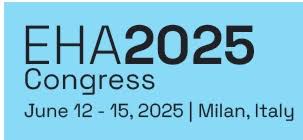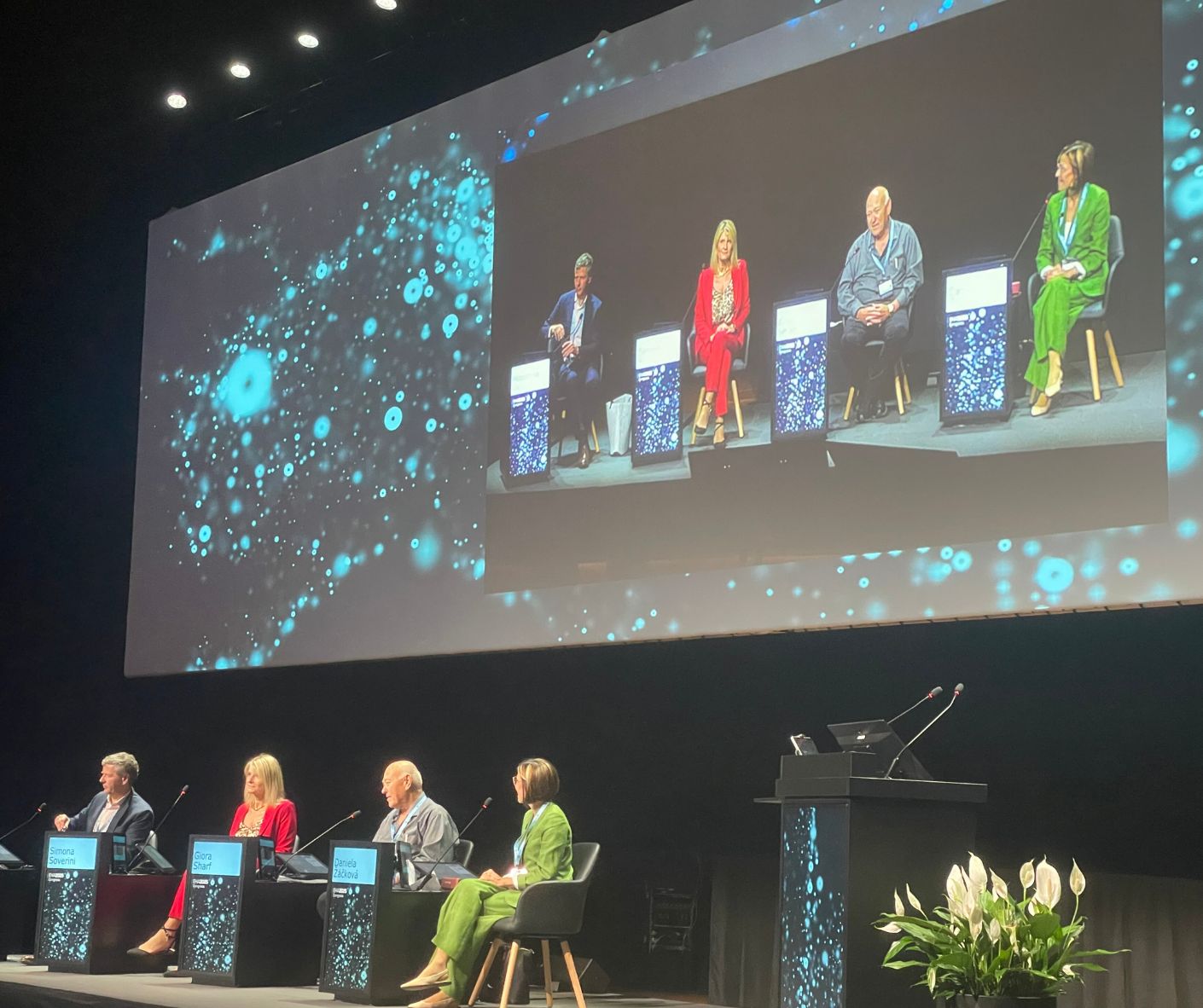
We're bringing you daily updates from the CML sessions at EHA2025 Congress. Check back each day for updates on the day's sessions.
Stay tuned for more coverage of CML @ EHA2025 over the next few days!
CML Summaries EHA2025 Congress – Day 3
Session: Oral Session: Chronic myeloid leukemia – Biological
Chairs:
- Tomasz Stokłosa (Poland)
- Ilaria Pagnani (Australia)
Presentation 1: Early response prediction by single cell immune and signalling profiling in CML
Speaker: Stein-Erik Gullaksen, Haukeland University Hospital (Norway)
“Early immune and signalling changes at the single-cell level can predict TKI response and help guide personalised treatment decisions in CML.” (Stein-Erik Gullaksen)
Key Points:
- Single-cell profiling predicts early response: TKI-induced changes in single-cell immune and signalling profiles (within 1–3 hours post-dose) strongly predicted patient responses, correlating with future BCR::AB1L levels.
- Mass cytometry enables deep resolution: Up to 60 antibody markers were used to assess over 350 samples, capturing dynamic changes in phosphorylation (e.g., pSTAT5, pCREB, pSRC) across >400 immune subsets.
- Different TKI responses reflect different biology: Dasatinib response was linked to leukemic burden and ERK/STAT3 changes, while nilotinib response was tied to apoptotic markers in leukemic stem cell-like cells.
- Predictive modelling is highly accurate: Machine learning models trained on these immune features showed strong correlations (R > 0.7) with actual BCR::ABL1 values and yielded robust ROC curves across time points.
- Toward personalised TKI selection: As summarised in the conclusion slide, this approach could help match each patient to the most effective TKI (dasatinib vs nilotinib) within hours of starting therapy.
Presentation 2: Impact of mitochondrial DNA mutations on metabolic adaptation and tyrosine kinase inhibitor response in CML
Speaker: Ilaria Pagani, SAHMRI (Australia)
“Our findings establish mitochondrial dysfunction as a key determinant of TKI sensitivity and a promising therapeutic target in CML.” (Ilaria Pagnani)
Key Points:
- Mitochondrial mutations correlate with TKI sensitivity: mtDNA mutations were enriched in TKI-sensitive patients and associated with reduced oxidative phosphorylation (OXPHOS), as shown in both bulk and single-cell data.
- Resistant cells show enhanced respiration: TKI-resistant CML cells displayed higher mitochondrial fitness (e.g., basal/max respiration, ATP production), despite only modest increases in mitochondrial mass.
- Transcriptomic data reveal metabolic rewiring: Resistant leukemic stem cells upregulated genes involved in mitochondrial biogenesis, lipid biosynthesis, and anabolic metabolism (e.g., BCAA, PPP pathways).
- Mitochondrial mutations may serve as biomarkers: Mitochondrial heterogeneity could be leveraged as a predictive biomarker of response to imatinib and other TKIs.
- Therapeutic targeting is promising but needs refinement: Complex I inhibitor IACS-010759 showed selective activity against CML stem/progenitor cells but was discontinued due to neurotoxicity - highlighting the need for less toxic agents that exploit mitochondrial vulnerabilities.
Presentation 3: Integrating genomic and transcriptomic insights for predicting responses and outcomes in patients with CML receiving 3rd-generation TKI therapy
Speaker: Xiaoshuai Zhang, Peking University People's Hospital (China)
“Integrated genomic and transcriptomic profiling identifies distinct subtypes that predict response to third-generation TKIs in CML.” (Xiaoshuai Zhang)
Key Points:
- High-risk mutations predict poor prognosis: ASXL1G646Wfs*12 (with VAF ≥ 30%), RUNX1, and PHF6 mutations were the most consistent genomic predictors of progression-free and survival outcomes under third-generation TKI therapy.
- Clonal evolution informs resistance: Longitudinal samples revealed dynamic patterns of mutation persistence and emergence (e.g., ASXL1, PHF6, BCORL1) that were enriched in resistant patients and linked to treatment failure.
- Distinct transcriptional subtypes stratify response: Patients were classified into three gene expression clusters - immune-activated (favourable), matrix-remodelling (intermediate), and stimulus-high/immune-cold (poor) - which correlated with outcome.
- Immune landscape influences TKI efficacy: The immune-activated subtype was enriched for T, NK, and NKT cells, while immune-cold subtypes showed low immune infiltration but higher progenitor/stem-like signals.
- Molecular stratification could guide therapy: As highlighted in the conclusion, integrating genomic and transcriptomic features may help identify patients unlikely to benefit from current 3rd-gen TKIs and point to alternative strategies.
Presentation 4: SETD2 deficiency in CML induces metabolic reprogramming contributing to drug resistance and disease progression
Speaker: Manuela Mancini, IRCCS Instituto Ortopedico Rizzoli – Seràgnoli Institute of Hematology, University of Bologna (Italy)
“Loss of SETD2 rewires metabolism and undermines genomic stability, contributing to CML progression and TKI resistance.” (Manuela Mancini)
Key Points:
- SETD2 loss drives metabolic rewiring: SETD2-deficient CML cells exhibited increased expression of glycolytic enzymes (e.g., HK2, LDHA, PDH) and reduced mitochondrial ATP production, shifting metabolism toward aerobic glycolysis.
- ROS and genomic instability are consequences: This metabolic state led to increased ROS production, which, combined with impaired DNA repair pathways, contributed to genomic instability and drug resistance.
- SETD2 loss is post-translational and druggable: SETD2 was not genetically deleted but degraded via proteasomal pathways—suggesting potential for therapeutic restoration
(e.g., via proteasome inhibitors). - SETD2 acts as a tumour suppressor: Overexpression of SETD2 in primary CD34+ CML cells reduced colony formation, confirming its role in suppressing leukemic stem cell proliferation.
- Targeting metabolic vulnerability is a therapeutic angle: The study’s conclusions highlight SETD2’s central role in linking metabolism and genetic stability, positioning it as a potential therapeutic target in advanced-phase or TKI-resistant CML.
Presentation 5: Comprehensive molecular characterisation of treatment-free remission and relapse in CML patients: The EURO-SKI biomarker study
Speaker: Sebastien Rinaldetti, Centre Hospitalier de Luxembourg (CHL), Hematology/Oncology Department (Luxembourg)
“Immune system coordination, especially involving NK and dendritic cells, is key to sustaining treatment-free remission in CML.” (Sebastien Rinaldetti)
Key Points:
- Immune activation underlies TFR success: patients with sustained TFR exhibited strong expression of immune effector genes (e.g., granzymes, NK receptors) along with upregulation of IFN-α, NK, and γδ T-cell signalling pathways at the time of TKI cessation.
- Relapse is linked to inflammation pathways and stemness: Relapsed patients showed enriched pro-inflammatory and hypoxia-related pathways (e.g., IL1R, MYD88) and higher expression of stemness-related genes.
- Regulon activity distinguishes patient states: Transcription factor networks (e.g., KLF1, GATA1) were activated in TFR patients and linked to erythroid progenitor signatures associated with better outcomes.
- Immune cell correlations reflect systemic readiness: In remission, but not relapse patients, plasma dendritic cells positively correlated with B and T cells - suggesting a primed and coordinated immune ecosystem.
- FLT3 emerges as a possible biomarker: Among genes investigated, only FLT3 remained statistically significant in the multivariable analysis. High FLT3 expression seems favourable, possibly due to its role in dendritic cell maturation.
CML Summaries EHA2025 Congress – Day 3
Session: Hematology-in-Focus: Chronic myeloid leukemia
Chairs:
- Daniela Žáčková (Czech Republic)
- Giora Sharf (Israel)
Presentation 1: BCR::ABL1 kinase domain mutations associated with asciminib
Speaker: Simona Soverini, University of Bologna (Italy)
Quotes:
"Any perturbation that prevents the adoption or disassembles this closed conformation will confer resistance, regardless of whether asciminib binding is retained or not… Asciminib resistance mutations cluster in different regions and we are seeing mutations we have not expected before.” (Simona Soverini)
Key Points:
- Resistance mutations extend beyond predictions: While in vitro studies suggested resistance mutations would cluster in or around the myristoyl-binding pocket, in vivo evidence shows they also occur in distant structural domains (e.g., SH3, SH2, N-lobe).
- Mechanism of resistance is conformational disruption: Asciminib inactivates BCR::ABL1 by stabilising a closed, inactive kinase conformation. Mutations that block or destabilise this conformation can cause resistance – even if drug binding is unaffected.
- Mutations cluster in distinct structural regions: Identified mutations disrupt asciminib function via various mechanisms, including steric hindrance, active conformation stabilisation, or impaired drug binding.
- Overlap with other TKIs may limit combinations: Some resistance mutations (e.g., M244V, F359V) affect both asciminib and ATP-competitive TKIs, potentially undermining combination treatment strategies.
- Sequencing protocols must evolve: Clinical detection of resistance mutations outside the kinase domain supports the need for broader sequencing (e.g., SH3/SH2 regions). The REACT database has been launched to centralise mutation data and guide future practice.
Presentation 2: Sequencing TKIs for optimal management of CML
Speaker: Hugues de Lavallade, King's College Hospital, London (United Kingdom)
“Sequencing is becoming more personalised... preventing the clonal expansion of TKI-resistant mutants rather than contracting already-grown mutants may improve outcome.”
(Hughes de Lavallade)
Key Points:
- TKI sequencing is increasingly complex and personalised: Treatment strategy must now account for disease risk, patient-specific factors, emerging mutations, and treatment goals (e.g., treatment-free remission).
- Somatic mutations beyond BCR::ABL1 matter: Mutations in other genes (e.g., ASXL1) can help identify higher-risk patients and justify earlier or more frequent kinase domain (KD) mutation monitoring.
- Upfront use of 3rd-generation TKIs like asciminib shows promise but requires caution: These agents may carry a higher risk of KD mutations, and longer-term data are needed to guide frontline use.
- KD mutations remain the only actionable resistance mechanism: While not the sole driver of TKI resistance, they are the ones we can currently target with therapeutic decisions.
- Prevention of clonal expansion is critical: Early detection and intervention to stop emerging resistant clones (before they dominate) may improve outcomes more than reacting to fully developed resistance.
Day 2:
Session: Oral Session: Chronic myeloid leukemia - Clinical
Chairs:
Susanne Saussele (Germany)
Franck Emmanuel Nicolini (France)
Presentation 1: ENABLE: A phase 1A/1B study of ELVN-001, a selective active site inhibitor of BCR::ABL1, in patients with previously treated CML (S165)
Speaker: Andreas Hochhaus, University of Jena, Germany
“ELVN-001 is a novel active site inhibitor of BCR::ABL1 that showed a favourable safety and tolerability profile in this phase 1 study. It also showed encouraging anti-CML activity in a heavily pretreated population.” (Andreas Hochhaus)
Key Points:
- Unmet needs in CML: ELVN-001 addresses off-target toxicities, drug interactions, and resistance mechanisms common with ATP-competitive TKIs.
- Mechanism of action: Targets the P-Loop in the inactive ATP-binding conformation, with activity against key mutations (e.g., T315I).
- Safety profile: No maximum tolerated dose and no dose-toxicity relationship identified; adverse events (AEs) were generally low-grade and manageable with low rates of dose reductions and discontinuation due to AEs.
- Efficacy in late-stage CML: 47% molecular response rate by 24 weeks, including 32% achieving MMR; 100% maintained prior MMR status; efficacy observed in patients exposed to prior asciminib or ponatinib.
- Pharmacokinetics: ELVN-001 pharmacokinetic profile supports once-daily dosing with or without food, which, in addition to low potential for drug-drug interactions, addresses key challenges with currently available TKIs.
Presentation 2: Asciminib shows superior tolerability vs nilotinib in newly diagnosed CML in chronic-phase: Primary endpoint results of the phase 3B ASC4START trial (S166)
Speaker: Andreas Hochhaus, University of Jena, Germany
“The safety profile of asciminib remained consistent with earlier trials with no new safety signals. There was a 55% lower risk of discontinuation due to adverse events with asciminib compared to nilotinib.” (Andreas Hochhaus)
Key Points:
- Study design and rationale: Focused on time-to-discontinuation due to adverse events (TTDAE) as a primary endpoint, addressing regulatory requests for tolerability data.
- Primary study endpoint: The ASC4START trial met its primary endpoint and asciminib demonstrated significantly superior tolerability vs nilotinib.
- Safety and tolerability results: The safety profile of asciminib remained consistent with earlier trials; TTDAE was significantly lower with asciminib (HR 0.45); key toxicities (liver, pancreas, rash) more common in nilotinib arm.
- Efficacy (Early response): Week 12 molecular responses – including MMR and 1% BCR::ABL1 thresholds – were higher with asciminib.
- Implications for practice: These data, along with the data from ASC4First, further support asciminib’s potential as a first-line standard-of-care option for newly diagnosed CML, with long-term TFR still under study.
Presentation 3: CML treatment discontinuation after a two-step dose reduction. The first results of the phase 2 study HALF (S167)
Speaker: Jiří Mayer, Masaryk University, Brno, Czech Republic
“We hypothesised that gradual de-escalation could reduce the loss rate of TFR and withdrawal symptoms. Data is still to be considered preliminary, but double-step de-escalation may become a new approach for stopping TKI therapy in CML patients.” (Jiří Mayer)
Key Points:
- Study design & hypothesis: Two-step dose de-escalation (50% dose for 6 months, then every-other-day for 6 months) before stopping TKIs to improve TFR success and reduce withdrawal syndrome.
- Treatment-free remission (TFR) rates: High TFR rates achieved; significant BCR::ABL1 level increase during de-escalation predicted relapse.
- Withdrawal syndrome reduction: Frequency of withdrawal syndrome is low; reduced musculoskeletal symptoms and fewer new/worsening symptoms compared to abrupt cessation.
- Metabolic insights: Imatinib cessation linked to decreased adiponectin and increased cholesterol, suggesting metabolic effects persist post-therapy.
- Future implications: Double-step TKI de-escalation strategy shown to be feasible and safe; full results expected in one year. Potential to redefine standard stopping protocols.
Presentation 4: Comparison of molecular response and safety of lower dose (70 mg) versus standard dose (100 mg) of generic dasatinib in newly diagnosed patient with CML-CP: Randomised controlled study from India
Speaker: Para Satadeve, Rajiv Gandhi Cancer Institute and Research Centre, Delhi, India
“Lower dose generic dasatinib 70 mg per day is non-inferior to the standard dose with fewer adverse events and has high clinical value, especially in resource-limited settings.” (Para Satadeve)
Key Points:
- Patient population: 120 newly diagnosed CML-CP patients in India; younger median age (39 years); majority high disease burden.
- Molecular efficacy: Lower dose generic dasatinib (70 mg/day) is non-inferior to the standard dose (100 mg/day) in achieving key molecular milestones across all risk groups
- Safety & tolerability: Significantly fewer hematological and non-hematologic toxicities, better tolerability, and fewer dose interruptions and reduction observed with dasatinib 70 mg/day.
- Cost and access: Generic dasatinib (~$210 or $180/year) and lower dose strategy offers effective and affordable care for low- and middle-income countries.
- Future directions: Study results suggest dasatinib 70 mg as a potential new standard of care, especially in LMICs to improve access, adherence, and outcomes.
Presentation 5: Characterisation and efficacy of TERN-701 in pre-clinical models of CML
Speaker: Timothy Hughes, SAHMRI, Adelaide
“We do not see evidence of any other kinase inhibition - even at high doses. TERN-701 is incredibly selective. It covers most mutations of concern – including 315, 317, and 244 – with high potency.” (Timothy Hughes)
Key Points:
- Mechanism of action & mutation coverage: TERN-701 binds the myristoyl (STAMP) pocket with high specificity, retaining activity against most BCR::ABL mutations including 315, 317, 244, and some compound variants.
- Selectivity profile: Screened against 450 kinases; showed clean profile with minimal off-target inhibition- including no significant ABL inhibition.
- Clinical Pharmacokinetics: Phase I data show high serum levels (500 mg QD achieves ~1,000 ng/mL), sufficient to cover IC50 and IC90 for nearly all mutations except a few allosteric variants (e.g., 468, 465).
- Limitations: Not effective in BCR::ABL-independent resistance (e.g., transporter issues, overexpression); broader activity (e.g., of ponatinib) may be needed in such cases.
- Pre-clinical development: Phase 1, dose escalation/expansion CARDINAL trial to evaluate safety and efficacy of TERN-701 is ongoing; additional preclinical studies are underway to further characterise TERN-701.
Day 1:
Session: Specialized Working Group Session:
Chronic myeloid leukemia and its stem cells
Chair: Nick Cross (UK)
Presentation 1: Modelling stem cell dynamics in CML
Speaker: Rick Van Etten, University of California, Irvine
“Both HSLL compartment size and self-renewal capacity influence the response to TKI therapy”
(Rick van Etten)
Key Points:
- Primary resistance modelling: Developed mathematical and mouse models demonstrating that leukemic stem cell (LSC) expansion and high self-renewal contribute to primary TKI resistance.
- Role of TET2 mutations: Found that TET2 mutations enhance self-renewal and worsen TKI responses, even if not within the BCR::ABL+ clone.
- Threshold and latency effects: Identified a ~4–5% LSC chimerism threshold needed for disease progression, with latency and stochastic effects suggesting non-mutational mechanisms.
- Immune and stress mechanisms: Proposed that immune surveillance and oncogene-induced replicative stress are critical for maintaining remission in the presence of residual LSCs.
- Clinical implication of model findings: These data challenge the paradigm that BCR::ABL1 is sufficient for leukemogenesis, and are consistent with other recent findings of non-mutational mechanisms of cancer development.
Presentation 2: Insights from single-cell analysis of CML stem cells
Speaker: Göran Karlsson, University of Lund
“We can now separate stem cells at diagnosis into CD26+ leukemic stem cells and CD35+ normal hematopoietic stem cells.”
(Göran Karlsson)
Key Points:
- Stem cell classification: Using single cell RNA-seq and antibody barcoding to distinguish CD26+ leukemic stem cells from CD35+ residual healthy stem cells.
- TKI sensitivity markers: Identified quiescent, CD26+/CKIT– cells as resistant to TKIs; MegE-primed clones responded better to therapy.
- Residual stem cell function: CD35+ cells were the only subset to show strong stem cell enhancer activity and long-term repopulating ability in mice.
- Prognostic utility of profiling: CD26/CD35 profiling at diagnosis predicted response quality and TKI cessation success; lack of CD35+ cells linked to poor outcomes.
- Blast crisis prediction: High-resolution single-cell data revealed that progenitor-like transcriptional shifts at diagnosis could predict transformation risk.
Presentation 3: 2025 ELN recommendations on the management of CML
Speaker: Jane Apperley, Imperial College London
“We aim to help clinicians personalise treatment … deciding whether the aim for therapy is improved survival or an attempt at treatment free remission, taking into account prognostic factors at diagnosis and comorbidities in the choice of therapy and obviously considering the affordability and availability in your country”
(Jane Apperley)
Background:
The European LeukemiaNet (ELN) has issued expert consensus recommendations for managing CML since 2006, with updates in 2009, 2013, and 2020. The 2025 version, recently accepted for publication in Leukemia, reflects evolving clinical data, new therapies, and a growing emphasis on individualised care.
Key Points:
- Classification and phase definition: WHO disease classification has removed accelerated phase (AP); ELN retains AP due to lack of panel consensus on phase classification. This offers flexibility for treating physicians.
- Prognostic markers: ELTS score and baseline chromosomal abnormalities retained as key risk indicators; somatic mutations (e.g., ASXL1) considered investigational.
- Response milestone updates: New categories ‘favourable’, ‘warning’, and ‘unfavourable’- aim to reduce stigma and clarify implications for therapy changes.
- Late responders and treatment switching: Emphasises individualised decision-making, especially for older patients or those with trending molecular improvement.
- TFR eligibility and early response: Strong early responders (<1% BCR::ABL1 at 12 months) most likely to achieve successful treatment-free remission.
- Treatment guidance: Newer TKIs, asciminib and olverembatinib, show improved molecular metrics but not yet overall survival benefit; starting dosage of more potent TKIs should be individualised.










